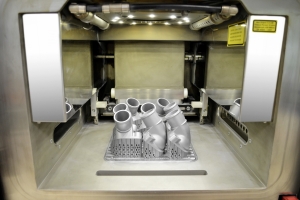Daimler “prints” first metal truck part
 STUTTGART, GERMANY – Engineers working for Daimler’s European truck brand, Mercedes-Benz Trucks, have successfully used a 3D printer to create a metal thermostat cover – proving a process that could reshape the way spare metal parts are produced and distributed.
STUTTGART, GERMANY – Engineers working for Daimler’s European truck brand, Mercedes-Benz Trucks, have successfully used a 3D printer to create a metal thermostat cover – proving a process that could reshape the way spare metal parts are produced and distributed.
With the potential of decentralizing production, 3D printing could improve parts availability, shorten delivery times, and reduce warehousing and distribution costs, the company notes. Daimler’s brands in North America include Freightliner and Western Star.
“With the introduction of 3D metal printing technology, Mercedes-Benz Trucks is reasserting its pioneering role among global commercial vehicle manufacturers,” said Andreas Deuschle, head of marketing and operations – customer services and parts with Mercedes-Benz Trucks. “We ensure the same functionality, reliability, durability and cost-effectiveness with 3D metal parts as we do with conventionally produced parts.”
The customer services and parts division began working with automotive 3D printers about a year ago, creating aftermarket and replacement plastic parts. Now working with metal, the 3D printers appear ready to produce small numbers of mechanically and thermally stressed components.
Put another way, different shapes of metal components can now be produced at the touch of a button — beginning with rarely ordered aluminium parts that match the density and better the purity of conventional die-cast aluminium parts. This could apply to peripheral metal engine parts, in-engine parts, cooling system components, transmissions, axles or chassis, the company says.
No special development work or special tools are required.
“The availability of spare parts during a workshop visit is essential for our customers – no matter how old the truck is, or where it is located,” Deuschle says. “The particular added value of 3D printing technology is that it considerably increases speed and flexibility, especially when producing spare and special parts. This gives us completely new possibilities for offering our customers spare parts rapidly and at attractive prices, even long after series production has ceased.”
The new thermostat cover now being made with 3D printers is only ordered in small numbers and used in older truck and Unimog models that ended production about 15 years ago.
Unlike the Selective Laser Sintering process used with plastics, the metal printing uses something called Selective Laser Melting. To make the thermostat cover, the powdered aluminium/silicon material is applied in layers and melted with one or more lasers.
Have your say
This is a moderated forum. Comments will no longer be published unless they are accompanied by a first and last name and a verifiable email address. (Today's Trucking will not publish or share the email address.) Profane language and content deemed to be libelous, racist, or threatening in nature will not be published under any circumstances.